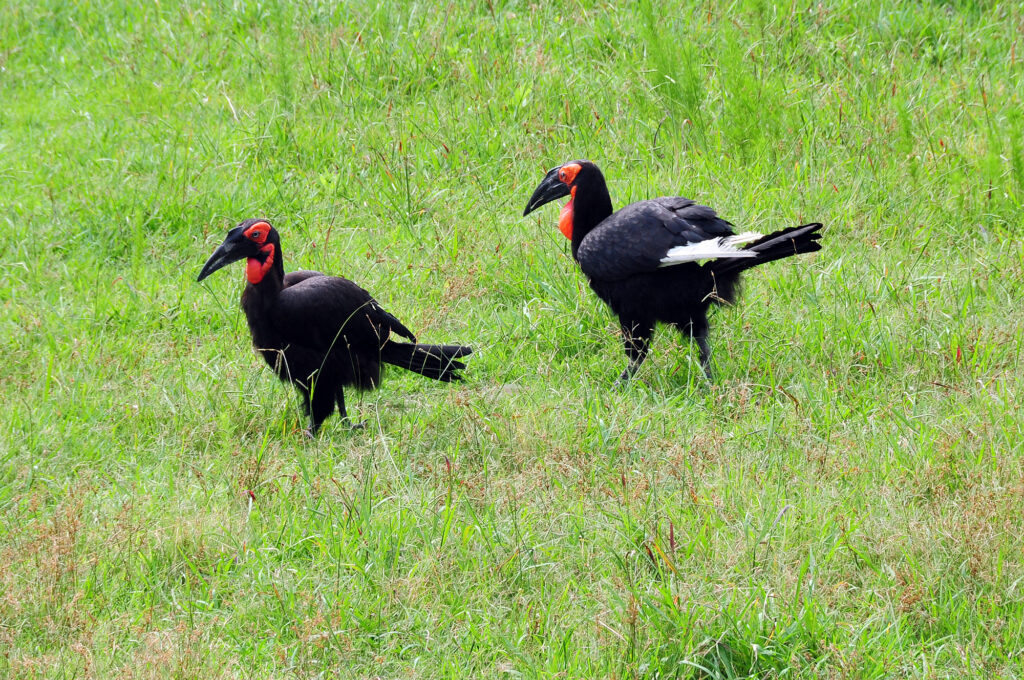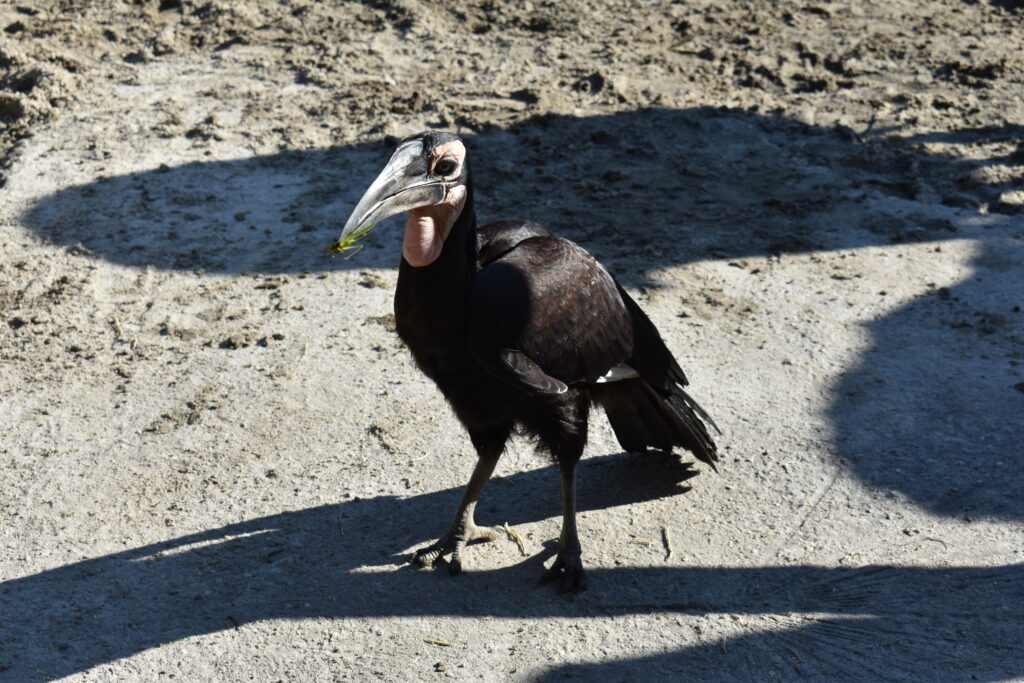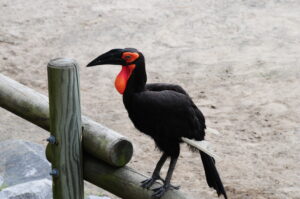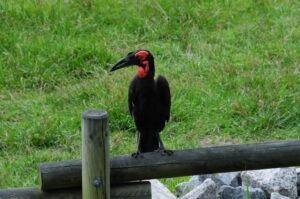Birds of a Feather
Several of the Virginia Zoo’s Africa Okavango exhibits are unique in that animals representing multiple species often live with each other, just as they could be found in the wild. The giraffe yard is no exception, with four different species of animals cohabitating together. The tower of Masai giraffes live with a small and elusive herd of Yellow-backed duikers, a dynamic duo of ostriches and an eclectic group of Southern ground hornbills. While the mammals in this exhibit are equally as interesting, this month’s Tales of the Tails blog features the Zoo’s three Southern ground hornbills.

Before introducing you to the members of the group, it’s important to know details about the species. Ground hornbills are the largest and heaviest of the hornbill species and are separated into two subspecies, the Abyssinian ground hornbill and Southern ground hornbill, which can be found at the Virginia Zoo. Southern ground hornbills (Bucorvus leadbeateri) are all almost entirely black with white wing feathers that can be seen when they take flight, although they only fly low to the ground for short periods of time. Both mature males and females also have a bright red throat sac, but females also have blue patches under their chins. These sacs, also known as gular sacs, are used for amplifying their unique calls.
These birds are predominantly carnivorous, feeding on reptiles, including snakes and tortoises, as well as frogs, toads, snails, insects or small mammals like rodents. Some are known to supplement their diets with fruit or seeds. Hornbills often capture or pick up their food at the end of their beaks then toss it into their mouths. Southern ground hornbills are found in southern African countries like Kenya, Angola, Namibia and Botswana. Their typical habitat consists of moist, open grasslands and savannas near scrub forests.

Hornbills live in groups of up to ten birds with one monogamous dominant pair and juveniles. Only the dominant pair breed while the younger birds defend the nest and territory and also help find food. While they can live up to 40 years in the wild and 50 years under human care, ground hornbills are some of the slowest reproducing birds and also face other threats. The species is listed as vulnerable to extinction by the International Union for Conservation of Nature (IUCN) due to habitat destruction and deforestation as well as poaching for the use of parts for medicine and rituals.
The Virginia Zoo contributes directly to the conservation of these birds by participating in the Species Survival Program® for hornbills, which oversees and manages species’ population in zoos by pairing individuals and monitoring breeding to maximize genetic diversity and long-term sustainability of populations. The SSP also ensures the species’ survival in the wild through supporting conservation efforts such as programs to combat poaching. The Zoo supports the Mabula Ground Hornbill Project, which works to protect hornbills in their natural habitats, educate the public about the importance of the species, assist in the creation of artificial nests, and hand-rear chicks for re-introduction into the wild.
 Jim, Jane and Jezebel are three Southern ground hornbills that can be found at the Virginia Zoo. Each has their own unique and completely different personality. Jim is the oldest of the three and was born on May 13, 1982 at the Jacksonville Zoo in Florida. The nearly-37-year-old arrived at the Virginia Zoo in May 2007 and weighs just over eight pounds. He appears to enjoy a variety of activities from eating new food items, picking up or manipulating items with his bill, interacting with his Keepers, hanging out with his family, hunting insects and collecting nesting material from around the yard. Jim can be distinguished from the other hornbills by his very large, reddish-orange throat sac.
Jim, Jane and Jezebel are three Southern ground hornbills that can be found at the Virginia Zoo. Each has their own unique and completely different personality. Jim is the oldest of the three and was born on May 13, 1982 at the Jacksonville Zoo in Florida. The nearly-37-year-old arrived at the Virginia Zoo in May 2007 and weighs just over eight pounds. He appears to enjoy a variety of activities from eating new food items, picking up or manipulating items with his bill, interacting with his Keepers, hanging out with his family, hunting insects and collecting nesting material from around the yard. Jim can be distinguished from the other hornbills by his very large, reddish-orange throat sac.
 Jim’s mate, Jane, was born on March 23, 2004 at the Tracy Aviary in Utah. She also arrived at the Virginia Zoo in May 2007 and recently weighed in at just over seven-and-a-half pounds. According to her Keepers, Jane is very shy around people, but is very social with her family. The 15-year-old enjoys wandering around the exhibit hunting insects and small prey. Jane is smaller than Jim and has a blue and orange-colored throat sac.
Jim’s mate, Jane, was born on March 23, 2004 at the Tracy Aviary in Utah. She also arrived at the Virginia Zoo in May 2007 and recently weighed in at just over seven-and-a-half pounds. According to her Keepers, Jane is very shy around people, but is very social with her family. The 15-year-old enjoys wandering around the exhibit hunting insects and small prey. Jane is smaller than Jim and has a blue and orange-colored throat sac.
 Jezebel is Jim and Jane’s chick, who had to be hand-reared by Keepers before and shortly after she was hatched on April 13, 2017. Hornbills usually have two eggs in a clutch, but will typically only care for one chick. Being first time parents, Keepers felt it was best to incubate the pair’s surviving fertile egg to ensure survival. Once Jezebel hatched and was strong enough, she was gradually reintroduced to her parents and now lives with them full-time. Because she was temporarily raised by her Keepers, Jezebel is very social with people. Animal care staff say she is also very curious since she is so young. Jezebel can be seen riding along in Keepers’ wheelbarrows while they clean the yard, hunting for insects with her parents and enjoying enrichment like digging around in piles of sand. Her throat sac is a pale pink color, which will turn redder with age, and she weighs just under six pounds.
Jezebel is Jim and Jane’s chick, who had to be hand-reared by Keepers before and shortly after she was hatched on April 13, 2017. Hornbills usually have two eggs in a clutch, but will typically only care for one chick. Being first time parents, Keepers felt it was best to incubate the pair’s surviving fertile egg to ensure survival. Once Jezebel hatched and was strong enough, she was gradually reintroduced to her parents and now lives with them full-time. Because she was temporarily raised by her Keepers, Jezebel is very social with people. Animal care staff say she is also very curious since she is so young. Jezebel can be seen riding along in Keepers’ wheelbarrows while they clean the yard, hunting for insects with her parents and enjoying enrichment like digging around in piles of sand. Her throat sac is a pale pink color, which will turn redder with age, and she weighs just under six pounds.
Guests can see the trio in the giraffe yard daily, although they often spend time out-of-view hunting or nesting in the shrubs and small trees around the exhibit as well as their nest boxes. On your next visit to the Zoo, be sure to stop by to say hello to the hornbills and visit the Gift Shop to purchase an endangered species t-shirt, available for $10 each at the Gift Shop counter. Proceeds from the sale of these shirts benefit the Mabula Ground Hornbill Project and Philippine Hornbills Conservation Program. You can also donate to the Zoo’s Conservation and Research Fund to help save hornbills in the wild.